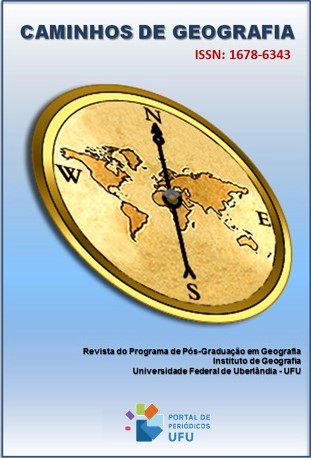O CONTEXTO TERRITORIAL DO SISTEMA CANTAREIRA E A GESTÃO INTEGRADA E PARTICIPATIVA DOS RECURSOS HÍDRICOS
DOI:
https://doi.org/10.14393/RCG249161644Palavras-chave:
Recursos hídricos, Gestão integrada, Sistema CantareiraResumo
Os Comitês das Bacias Hidrográficas dos Rios Piracicaba, Capivari e Jundiaí (Comitês PCJ) estão entre os mais avançados na implementação do modelo de gestão integrada e participativa dos recursos hídricos. Porém, a transposição das águas da bacia hidrográfica do Rio Piracicaba para a do Alto Tietê pelo Sistema Cantareira, para abastecer a Região Metropolitana de São Paulo, coloca desafios à aplicação desse modelo. O artigo apresenta como o contexto territorial do Sistema Cantareira integra debates e ações que emergem dos Comitês PCJ, demonstra em que medida os atores sociais deste contexto estão presentes em seus espaços públicos e discute tais aspectos com base na noção da gestão integrada e participativa. Para tanto, analisaram-se atas de reuniões, o Plano de Bacia Hidrográfica e informações dos Comitês PCJ. Identificou-se que o Sistema Cantareira é encarado mais como uma obra de engenharia hidráulica, e menos como um contexto que possui múltiplas problemáticas relacionadas aos recursos hídricos. Além de parcos investimentos direcionados a tal contexto, soma-se a inexpressiva representação dos seus atores sociais como membros dos espaços públicos dos Comitês PCJ. Conclui-se que estes aspectos são lacunas à plena gestão integrada e participativa dos recursos hídricos.
Downloads
Downloads
Publicado
Edição
Seção
Licença
Copyright (c) 2023 Rafael Eduardo Chiodi

Este trabalho está licenciado sob uma licença Creative Commons Attribution-NonCommercial-NoDerivatives 4.0 International License.
Autores que publicam nesta revista concordam com os seguintes termos: a) Autores mantém os direitos autorais e concedem à revista o direito de primeira publicação, com o trabalho licenciado sob a Creative Commons Atribuição-NãoComercial-SemDerivações 4.0 Internacional. b) Autores têm permissão e são estimulados a publicar e distribuir seu trabalho online (ex.: em repositórios institucionais ou na sua página pessoal), já que isso pode gerar alterações produtivas, bem como aumentar o impacto e a citação do trabalho publicado. c) Em virtude de aparecerem nesta revista de acesso público, os artigos são de uso gratuito, com atribuições próprias, em aplicações educacionais e não-comerciais.











